Today’s pedal line is from Gary Vogel. If you have a pedal line (doesn’t have to be in a board) for your rig, please email me a photo, bio, description of pedals and routing to pedalline@nulleffectsbay.com. Every Friday I’ll showcase a pedal line submission. Make sure you include any links to your band or music page.
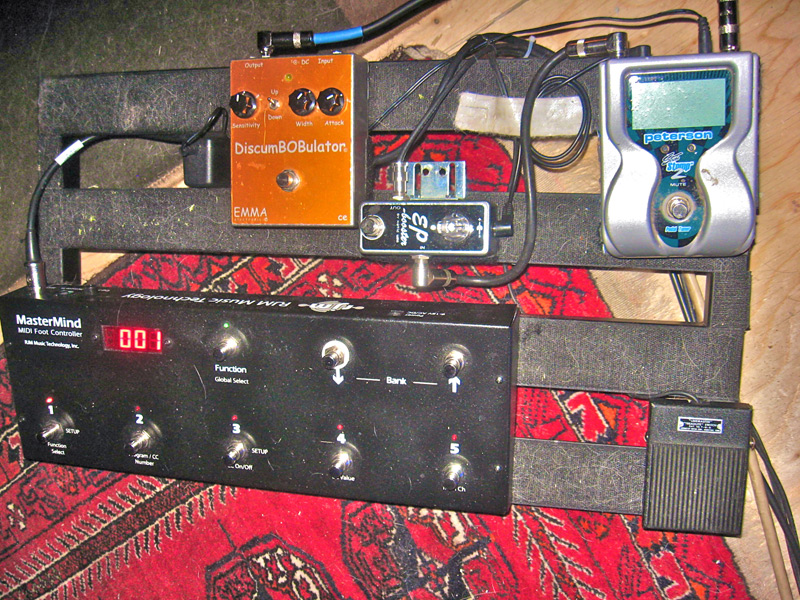 I hate tapdancing, and rarely adjust my settings onstage unless necessary. Also, I am tall and clumsy, so bending down to twiddle knobs on a big pedalboard is a big drag for me.
I hate tapdancing, and rarely adjust my settings onstage unless necessary. Also, I am tall and clumsy, so bending down to twiddle knobs on a big pedalboard is a big drag for me.
I also love the width and spread of a big stereo sound, especially in my power trio where I am the only guitar or melody instrument and need to fill a big space. Yes, I know soundmen disdain stereo guitar for lots of good reasons, mainly due to the zoned-mono nature of PA’s– but if I am jazzed about my tone, I play better.
I get most of my dirt from my amp, which used to be a Fryette/VHT Pittbull 50ST. That killer amp has a great FX loop with a level control, and the distortion was ideal for me. But when I tried the new Fender-made EVH III, I liked that dirt even more, and the clean tones much better. The clean tone power of the EVH allows my pedals to really shine through.
My philosophy is to place my FX in the best place for their nature. To that end, I use some pedals before the amp, some in the FX loop, and some stereo ones on the preamp output into a variety of stereo amps, depending on the type of gig. Here is my main rig for most gigs:
ON THE FLOOR BOARD:
EMMA Discumboblulator Envelope Wah –> Exotic EP Booster –> Peterson Strobostomp 2
Also on the floor is a momentary switch connected to my Timefactor Delay for stomp tempo adjustments. The Emma is true hardwire bypass, so it is fine at the beginning of the chain, where it sounds the best when it is on.
This pedalboard feeds the “Guitar In” jack of a G-String Decimator noise gate, which senses the mostly-unprocessed guitar tone to control the noise later in the line. The “Guitar Out” jack of the Decimator feeds the input of my RJM RG-16 midi switcher, controlled by an RJM MasterMind on the floor. I don’t use the buffer on the RG-16, as there is one already on the Decimator. The RG-16 switches several FX in and out, and also switches the channels on the EVHII amp. Here are the FX in order:
IN MY RACK:
1) Whirlwind Rochester model DynaComp reissue –set to heavy compression and unity gain
2) MXR 6-Band EQ, used for extreme mid boost
3) Lovepedal 11– used to impart a mild, warm dirt on the EVH clean channel, a dirt that is not available with the EVH channels set the way I like: Ultra clean on CH 1, main heavy dirt on CH 2, and extreme gain on CH 3. In this case, I set it to achieve a Stones/Ya-Ya’s Out tone. This pedal is perfect for this, and I set it so that it works with the eq on CH1 of the EVH set for sparkling tight clean. I can also goose this with the compressor or the 6-band, giving a couple more options. The compressor into Eleven combo is great for fusion-type leads– mellow, and warm, but tons of sustain and dirt.
4) MXR 10-Band EQ, set to a typical “smile” curve for carving up the compression if I need it sharp instead of warm.
5) Loud Button WTF pedal, set for radical exploding bomb, or ray-gun effect. This baby always turns heads when I switch it on!! Demo here: http://www.loudbutton.com/wtf_index.html
6) Soundblox Multiwave Distortion— I usually use this on setting #13, with minimal dirt and sustain, and max output. This creates an awesome Green Ringer type fuzz, really cutting, but very very musically useful. It also sounds great into the clean amp channel on setting #4 with max dirt, low sustain and unity output. This setting almost sounds like a digital keyboard sample of a metal guitar tone, and it is wicked for playing maj7ths, maj9ths, and other complex chords–really different! I always run this pedal into the clean channel, as I have never found a good tone by sending this into a dirty amp.
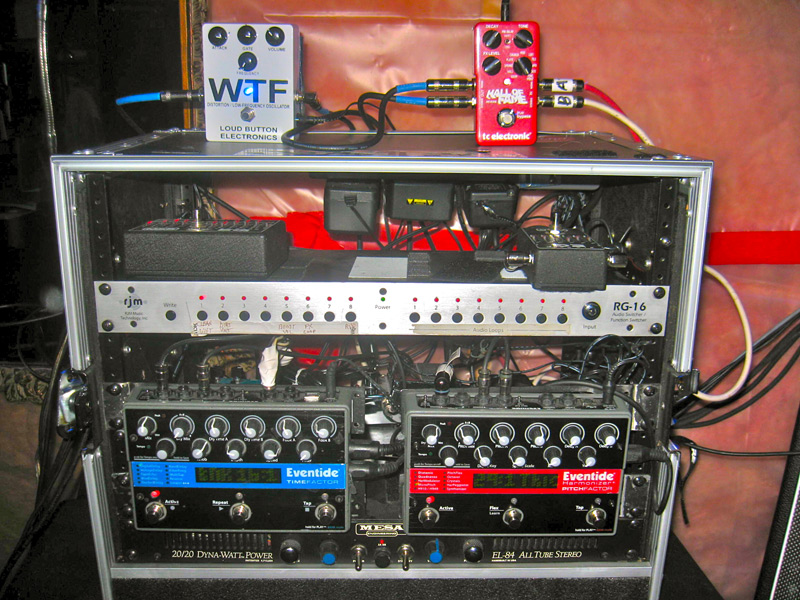 (Note: in the photo, you cannot see the Soundblox and the Decimator, as they are in the back of the rack)
(Note: in the photo, you cannot see the Soundblox and the Decimator, as they are in the back of the rack)
These then feed into the input of the EVH III amp. The series loop of the amp runs first into the DC in jack on the G-string Decimator. This really removes a ton of noise and hiss! I can even use a stock Fender guitar! The signal then goes into my Eventide Timefactor delay, MIDI-switched by the RGM Mastermind. Putting the gate before the Eventide ensures that it does not mess with the tails of the delays, etc.
The speaker out of the EVH feeds a “Center” speaker cab, either a VHT Fattbottom 2X12, or a Marshall 1960 4X12 w/ 70 watt Celestions. This is mic’d by the soundman for my main tone through the PA. Soundmen usually find this easy to mic and use in their mix, but I take great pains to even out the volume levels on all the tones, which is quite difficult to achieve, esp when using the WTF pedal.
The preamp out of the amp comes back into rack, where it feeds the Eventide Pitchfactor in mono-in, stereo-out mode. This pedal is so awesome, I cannot live without it now. By far the BEST chorus tones, diatonic harmonies, weird noise patches, synth tones, all in stereo so they are HUGE. The micropitch settings allow the famous “Zakk Wylde” stereo spread he used on the studio Ozzy albums: one side +9 cents, 23ms delay and the other side -9 cents, 11 ms delay.
The stereo output feeds a TC Electronic Hall of Fame Reverb with stereo in/out, which recently replaced a Hardwire RV-7 reverb. The reverb is switched in and out by the RG-16 via channels 7 & 8, which are both independent isolated loops. I still dig the RV-7 for some of the hall and plate tones, but overall the Hall of Fame is just a bit more useful, and more musical for distortion tones for some reason. The sound of the stereo modulated reverb is superb, even on dirty sounds, and the downloadable “Toneprint” tone called “Room With a View” is a variation of this that really works wonders for chimy, dreamy tones. I place this on top of the rack along with the Soundblox and the WTF pedals, so I can switch between presets for different songs.
Note that both the Timefactor and Pitchfactor have hardwire bypass switching, using the midi input on the pedal. This feature is so great! It frees up the switching loops for other pedals.
The stereo out from the RG-16 channels 7 & 8 finally feeds a power amp. Usually this is a Mesa Boogie 2 X 20 Dynawatt EL-84-based Stereo power amp. I have modified the Mesa amp with the “Deep Mod” which you can google online– long story short, it reduces the typical midboost character of the amp, allowing more low end. Easy to do, if you can follow directions and have good solder skills, or get a qualified tech to do it.
Sometimes at larger gigs, I use my VHT 2X50 power amp, with EL-34’s. The Mesa is lighter, and usually powerful enough. I also have a Rocktron Velocity 300 amp as backup.
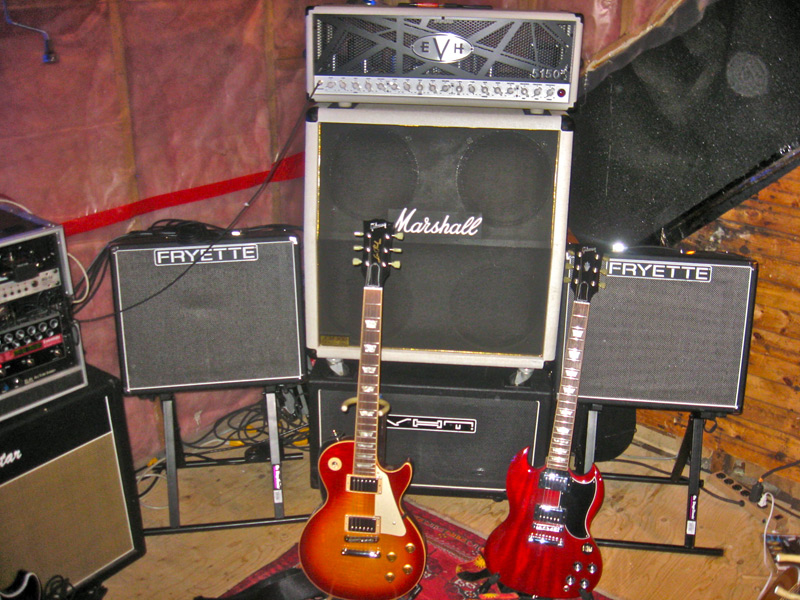 The amp drives a pair of Avatar 1X12 cabs w/ 80-watt Celestions for maximum bass and low speaker breakup. These are placed on the sides of the mono amp cab, to increase stereo spread. Sometimes I augment the stereo feel by using a stereo Marshall 4X12 cab on top of my mono/center VHT cab. Since the Avatar cabs are 8 ohm, and each side of the stereo Marshall is 8 ohm, this makes each side 4 ohms.
The amp drives a pair of Avatar 1X12 cabs w/ 80-watt Celestions for maximum bass and low speaker breakup. These are placed on the sides of the mono amp cab, to increase stereo spread. Sometimes I augment the stereo feel by using a stereo Marshall 4X12 cab on top of my mono/center VHT cab. Since the Avatar cabs are 8 ohm, and each side of the stereo Marshall is 8 ohm, this makes each side 4 ohms.
A wussy band was scared by this rig, which they referred to as “The Doomsday Device.”  It is a bit of a drag to transport, but for all the hassle one endures playing original music, who cares about that? It is very reliable, and quick and easy to set up, which most find surprising. Also easy to use onstage– I don’t spend much time tweaking tones at all, other than adjusting for room acoustics, which is done on the amp channels.

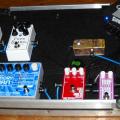
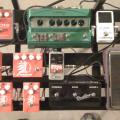
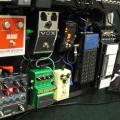
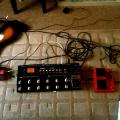
Leave a Reply